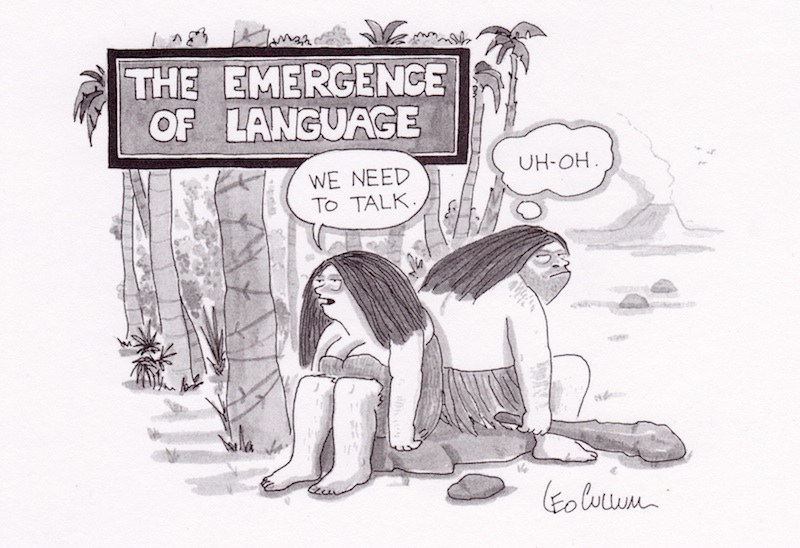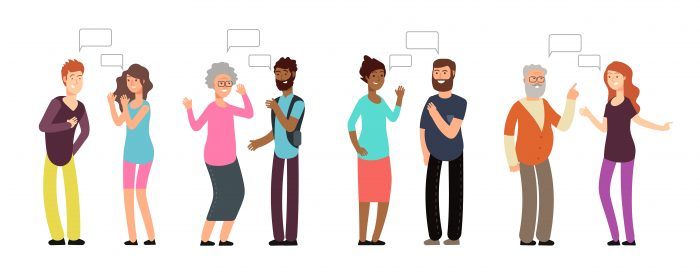LANGUAGE
Origin of Language
The Divine Source
In most religions, there appears to be a divine source that provides humans with language. To discover this “Original Divine Language”, a few experiments have been carried out. They were based on the fact that human infants would spontaneously develop the original God-given language by being isolated. Those experiments are:
First Experiment
2,500 years ago, the Egyptian pharaoh tried the experiment with two newborn babies. After two years of isolation, except for the company of goats and a mute shepherd, the two infants were reported to have spontaneously emitted, not an Egyptian word, but it was identified as the Phrygian word “bekos”, meaning “bread.” For him, the children developed “the original language” given by God.


Second Experiment
Around the year 1500, King James the Fourth of Scotland tried a similar experiment. As a result, the children were reported to have spontaneously started speaking Hebrew, confirming the King’s belief.

It is important to know that all the other cases of isolated children tended not to confirm this "divine source theory" because young children who lived in isolation grew up without any language.

The Natural Sound Source
This theory explains that human beings develop language by imitating the sound heard from their surroundings.
Example: An object flew by, making a CAW-CAW sound, and humans would name it and refer to it according to the sound it made.

“Bow-wow theory”: Words that echo natural sounds. Examples: splash, bang, boom,
Some original sounds of language may have come from natural cries of emotion, such as pain, anger, and joy. Examples: Ouch! Ah! Wow!

The Social interaction Source
The “yo-he-ho” theory explains that human beings could develop language while they were doing a physical effort because this one involved several people, and the interaction had to be coordinated.
Example: A group of human beings might develop a set of hums, grunts, groans, and cries while they were lifting and carrying large bits of trees and other heavyweight objects.

The Physical Adaption Source
The evolved posture of human beings might have influenced the production of speech:
- Upright position
- Bipedal locomotion
- Role of front limbs (brain)
Examples
1. The transition that our ancestors made to an upright posture, with bipedal (on two feet) locomotion, and a revised role for the front limbs.
2. The reconstructed vocal tract of a Neanderthal.
Physical Changes
Teeth: Upright position.
Lips: Intricate set of muscles.
Mouth: Small.
Tongue: Flexible muscle.
Head: Above the spinal cord.
Larynx: Lower position and contain vocal folds.
Pharynx: Above vocal folds and resonator.

The Tool-making Source
Manual gestures may have been a precursor of language.
Tool-making is evidence of a working brain.
Lateralization of the brain leads to:
1. Specialization of functions
2. Left hemisphere in charge of object manipulation, muscle movement, and speaking.
The evolutionary connection of tool-using and language-using might have been involved in the development of the speaking brain.


The Genetic Source
This theory refers to the “Innateness Hypothesis”, in which human offspring are born with a special capacity for language. It is innate, no other creature seems to have it, and it is not just to a specific variety of language.
Genetic mutation from ancestors

The “Innateness Hypothesis” pointed out that there was something in human genetics, possibly a crucial mutation, as the source, like a “language gene” that only human beings possess.
The possession of language distinguishes man from other animals. Only human beings can develop it.
Properties of Human Language

Reflexivity
Human beings think and talk about language itself.

Displacement
Human beings can refer to past, present, and future, while animals can just communicate in present. Also, displacement allows humans to talk about things and places whose existence has not even been proved. For example, Santa Claus, Easter Bunny, witches, angels, heaven, and hell.
Example: When a cat meows to his or her owner, the owner is likely to understand the message that the animal is relating to that immediate time and place, but if the owner asks the cat “Where have you been?”, the owner will get the same “meow” response. The answer will not change because animals cannot refer to different tenses.


Arbitrariness
It is the relationship between linguistic signs and objects in the world. This property claims that words and their meanings do not have a connection between them.


Productivity or Creativity
New words or word combinations can be created based on experiences.
Example: When bees find another nectar source, they go back to the beehive and performer a specific dance to indicate the direction where the honey is. However, if the honey was moved, they would not be able to find the nectar. The bees could only communicate that the nectar was toward a horizontal path, but they cannot create a message to indicate that the nectar is now located in a vertical path.


Cultural Transmission
Learning any language by the culture passed from one generation to another.
Example: Birds develop their songs to communicate. If those birds spend their first seven weeks without hearing other birds, they will instinctively produce songs or calls, but those songs will be not normal, in other words, like the songs that the other birds normally sing.


Duality
Human language is divided into two levels:
Physical level: Articulation of symbols (e - m - a -t) - Distinct sound.

Meaning level: Combination of sounds (Team or Mate) - Distinct of sound.


Patterning
Combination of discrete sounds is systematic (well-defined patterns)
Examples with words
o - p - t: Pot or Top
u - g - m: Mug or Gum
Examples with sentences
go - store - quickly - please - to:
1. Please, go to the store.
2. Go to the store, please.
Other Properties
Vocal - Auditory channel
Produced with vocal organs, perceived through the ears.

Reciprocity
Exchange of rules (sender-receiver)

Examples: Conversations, debates, discussions, etc
Specialization
Language symbols
Non - directional
Not easily direct speech to one listener.

Example: Webinar meetings
Rapid Fade
Quickly produced and disappeared.
Prevarication
Language signals can be false and language signals can be used to lie or deceive.

